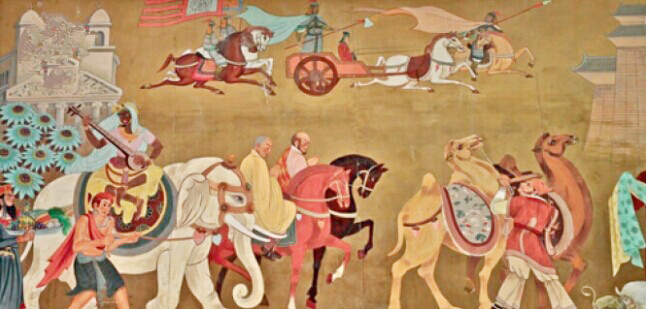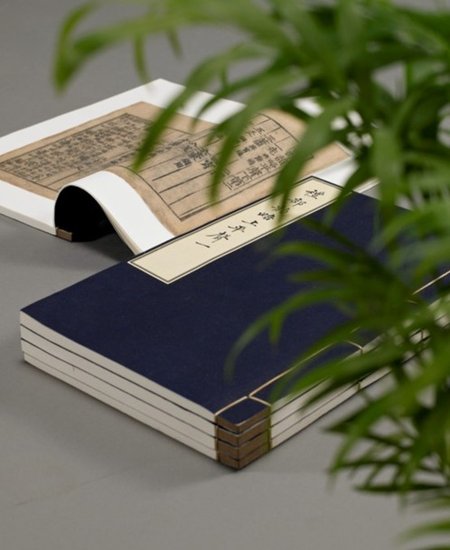Northern Song helped shape world civilization

Foreign merchants and monks shuttled back and forth between their home countries and China along the ancient Silk Road during the Song Dynasty, engaging in commodity and cultural exchanges with their Chinese counterparts.

Advanced culture, laws and institutions of the Northern Song Dynasty had great influences on the Korean Peninsula.
In Chinese history, the Song Dynasty (960-1279) was divided into two distinct periods: Northern (960-1127) and Southern (1127-1279). The Northern Song Dynasty was notable for its thriving economy, rich culture and complex diplomacy. The imperial court adopted flexible, pragmatic foreign policies and fostered extensive diplomacy with East Asia, Southeast Asia, Central Asia, West Asia and East Africa to carry forward the Chinese nation’s culture, tradition and material civilization.
Influence on Korea, Japan
Although China and Korea didn’t share a border during the Song Dynasty, Korea provided a balance between the Song (960-1279) and Liao (907-1125) regimes. Following the signing of the Chanyuan Treaty between the Northern Song and Liao empires, the Song court and Korea maintained peaceful diplomatic relations.
After Emperor Shenzong (reigned 1068-85) assumed the throne, his court took a positive approach to diplomacy with Korea. Admiring the brilliant civilization of the Chinese nation, Korea strived to emulate the Song model.
Korea imported apparel and accessories, jade articles, silk fabrics, tea, medicinal materials, musical instruments and books from China. In terms of cultural exchange, it benefited from the Song’s advanced culture, laws and regulations.
Korean envoys were especially interested in Song poetry, paintings and calligraphy. Therefore, Korea often sent envoys and painters to the Song court to observe and learn painting and calligraphy styles. On the walls of the famous Hungguk Temple’s main hall in modern-day Kaesong, North Korea, there is a copy of a mural in the Xiangguo Temple in Kaifeng, Henan Province, Emperor Huizong (reigned 1101-25) once presented his own painting and calligraphy works to the king of Korea.
Korea also valued medical science of the Song Dynasty, dispatching doctors many times to China to gain medical books and medicine. In 1074, under Emperor Shenzong’s reign, the king of Korea sent envoys to the Song court in search of medical experts, skilled painters and craftsmen to teach the Korean people.
Under Emperor Huizong’s rule, the imperial court dispatched reputed doctors to Korea twice to teach different branch subjects of medical science and train medical professionals. In the early 12th century, the movable-type printing press, a great invention from the Northern Song Dynasty, gained popularity in Korea. In the political sphere, traces of the Song Dynasty can be found in many Korean systems.
Japan was also deeply influenced by traditional Chinese culture. In the Northern Song Dynasty, China and Japan relied on two shipping routes to keep economic and trade contact. China’s key ports included Dengzhou (modern-day Penglai, Shandong Province), Yangzhou and Chuzhou (modern-day Huai’an), Jiangsu Province.
Japan’s Fujiwara regime adopted closed-door policies and banned private sea trade during this time. Consequently, few Japanese ships came to China, but many Song ships went to Japan. During the Northern Song Dynasty, Chinese ships made more than 70 voyages to Japan and exported commodities, such as chinaware, silk fabrics, handiwork, spice, medicines, Buddhist scriptures and books.
In the Song Dynasty, cultural exchanges between China and Japan were dominated by Buddhist monks’ exchanges. In 1073, the fifth year of Emperor Shenzong’s reign, Japanese monk Joujin arrived in Kaifeng, then capital of China, and offered silver censer, white glaze, crystal and amber prayer beads as tributes to the emperor. Japanese monks thereafter regularly came to China on pilgrimages to Buddhist temples.
Swords and folding fans brought by Japanese monks were popular among Song intellectuals and officials. In return, Japanese monks usually took books back to their country. The introduction of Song block-printed books and Buddhist scriptures fueled an early boom in Japan’s printing industry.
Exchanges with SE Asia, South Asia
The Champa Kingdom, which extended across the coast of modern-day central and southern Vietnam, and the Kingdom of Cochin, a late medieval Hindu kingdom in South India, had tributary and trade relations with the Song court.
During the Song Dynasty, merchants departed from Quanzhou, Fujian Province, and Guangzhou, Guangdong Province, to Champa and Cochin. Merchants from the two kingdoms also delivered goods to the two Chinese ports by sea, receiving silk, porcelain, accessories, Buddhist scriptures and books in return.
The Champa and Cochin kingdoms acquired many Confucian books. Song brocade techniques also spread into Cochin, where palace maids adapted them with distinct local features.
In the early years of the Northern Song Dynasty, Champa rice was brought to Fujian Province. In 1011, under the reign of Emperor Zhenzong (reigned 998-1022), Zhejiang Province and regions between the Yangtze and Huai rivers were plagued by severe drought. The emperor subsequently ordered Champa rice from Fujian to be cultivated in drought-stricken areas. Gradually, the rice became the main grain crop in the Yangtze River basin.
Srivijaya, a city-state based in modern-day Sumatra, Indonesia, was a hub for international trade in Southeast Asia. It sent envoys to the Song court more than 30 times.
Nations in today’s Indian Peninsula maintained good economic, trade and cultural exchanges with China throughout the Northern Song Dynasty. Through communication and mutual learning, the two ancient civilizations absorbed cultural influences from each other.
In 980, during the rule of Emperor Taizong (reigned 976-97), Indian Buddhists Dharmabhadra and Danapala visited Kaifeng. When the emperor asked them about local customs and practices in India, they introduced religions, geography, climate and natural resources in the Indian Peninsula in fluent Chinese.
Relations with the Arab World
In 968, during the rule of Emperor Taizu (reigned 960-75), Arab kings sent envoys to China to pay tribute. Three years later, an envoy in the second delegation was conferred the title Civilizing General (Huaihua Jiangjun) by the Song court along with a golden-flower, five-colored silk commission. Arab envoys thereafter regularly came to China.
The Song Empire and Arab countries enjoyed well-developed maritime transportation. Sextants were widely used to navigate the seas. During their voyages to Asia, Arab envoys and merchants often transferred to the eastward Song merchant ships via modern-day Kollam off the southwestern coast in India.
Islam and its architectural art were introduced to China in the Tang Dynasty (618-907) and further promoted in the Song Dynasty. Arab-style temples and houses were built in Quanzhou and Guangzhou, allowing Arab merchants to retain their native architectural style and draw upon the essence of Song architecture. Among these buildings is the Qingjing Mosque, also known as Qilin Temple, in Quanzhou. Built in 1009 during the reign of Emperor Zhenzong, the mosque is approximately 2,500 square meters and the oldest of its kind in China.
Reaching out to Africa
The Song Dynasty even extended its influence to Africa, attracting many diplomatic missions to China. In 1072, during Emperor Shenzong’s reign, envoys were sent from modern-day Tanzania to Guangzhou. In 1083, an African delegation was received by the Song court and offered local specialties. In return, Emperor Shenzong granted them 2,000 taels of silver coins. Silk, porcelain and copper coins were also transported, directly or indirectly, by Chinese business vessels to Tanzania.
Modern discoveries of Song ceramics and copper coins along the coast of Tanzania also indicate that China had close economic and cultural ties with Tanzania in the Song Dynasty.
In 1945, ancient Chinese coins were discovered in Mogadishu, capital of Somalia. Coins from the Northern Song Dynasty were in the largest number, suggesting frequent ancient trade between China and Central Africa.
In The Records of Foreign countries (1225), Song geographer Zhao Rukuo gave detailed accounts of the Egyptian ports of Alexandria, Damietta and Cairo.
The Northern Song Dynasty transmitted science, technology, culture and ideas of the Chinese nation throughout the world, making significant contributions to the development of global civilizations. As French Sinologist Étienne Balázs said, the Song Dynasty exerted the greatest influence on world civilization among all Chinese dynasties.
Tian Zhiguang is an associate professor from the School of History and Culture at Henan University.
